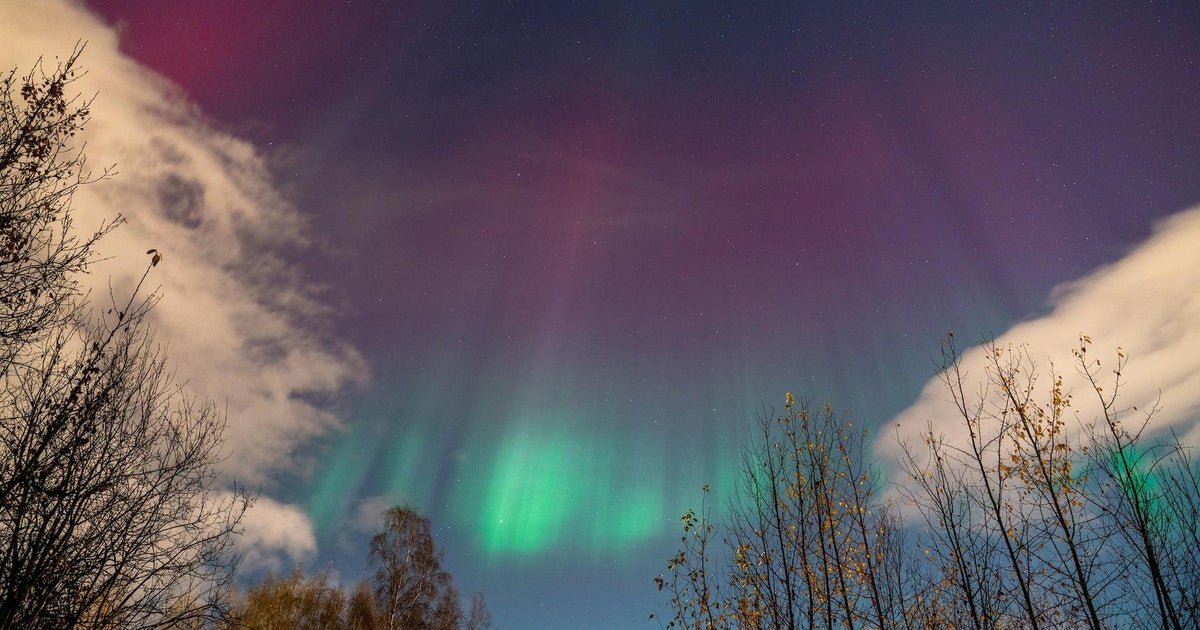CBS News
Large solar storms can knock out electronics and affect the power grid – an electrical engineer explains how

David Wallace is an assistant clinical professor of electrical engineering at Mississippi State University.
The geomagnetic storm that began on May 10, 2024, generated stunning aurora borealis, more commonly known as the northern lights, that could be seen as far south as Mexico. They also generated headaches for farmers whose GPS-guided tractors were idled in the middle of planting season.
Geomagnetic storms occur when a large bubble of superheated gas called plasma is ejected from the surface of the Sun and hits the Earth. This bubble is known as a coronal mass ejection. The plasma of a coronal mass ejection consists of a cloud of protons and electrons, which are electrically charged particles. When these particles reach the Earth, they interact with the magnetic field that surrounds the planet. This interaction causes the magnetic field to distort and weaken, which in turn leads to the strange behavior of the aurora borealis and other natural phenomena.
The May 2024 storm, rated G5 on the National Oceanic and Atmospheric Administration’s 1-to-5 Geomagnetic Storms scale, disrupted GPS communications enough to throw off tractor guidance, which requires centimeter-level precision. Stronger storms would have much more serious consequences. As an electrical engineer who specializes in the power grid, I study how geomagnetic storms also threaten to cause power and internet outages and how to protect against that.
Geomagnetic storms
Stronger solar storms have happened, and one caused havoc with one of the earliest electronic technologies. On Sept. 1 and 2, 1859, telegraph systems around the world failed catastrophically. The operators of the telegraphs reported receiving electrical shocks, telegraph paper catching fire and being able to operate equipment with batteries disconnected. During the evenings, the aurora borealis could be seen as far south as Colombia. Typically, these lights are only visible at higher latitudes, in northern Canada, Scandinavia and Siberia.
What the world experienced that day, now known as the Carrington Event, was the largest recorded account of a geomagnetic storm, far stronger than the May 2024 storm.
Geomagnetic storms have been recorded since the early 19th century, and scientific data from Antarctic ice core samples has shown evidence of an even more massive geomagnetic storm that occurred around A.D. 774, known as the Miyake Event. That solar flare produced the largest and fastest rise in carbon-14 ever recorded. Geomagnetic storms trigger high amounts of cosmic rays in Earth’s upper atmosphere, which in turn produce carbon-14, a radioactive isotope of carbon.
A geomagnetic storm 60% smaller than the Miyake Event occurred around A.D. 993. Ice core samples have shown evidence that large-scale geomagnetic storms with similar intensities as the Miyake and Carrington events occur at an average rate of once every 500 years.
Scientists were able to estimate the strength of the Carrington Event based on the fluctuations of Earth’s magnetic field as recorded by observatories at the time. There was no way to measure the magnetic fluctuation of the Miyake Event. Instead, scientists measured the increase in carbon-14 in tree rings from that time period. The Miyake Event produced a 12% increase in carbon-14. By comparison, the Carrington Event produced less than a 1% increase in carbon-14, so the Miyake Event likely dwarfed the G5 Carrington Event.
Knocking out power
Today, a geomagnetic storm of the same intensity as the Carrington Event would affect far more than telegraph wires and could be catastrophic. With the ever-growing dependency on electricity and emerging technology, any disruption could lead to trillions of dollars of monetary loss and risk to life dependent on the systems. The storm would affect a majority of the electrical systems that people use every day.
Geomagnetic storms generate induced currents, which flow through the electrical grid. The geomagnetically induced currents, which can be in excess of 100 amperes, flow into the electrical components connected to the grid, such as transformers, relays and sensors. One hundred amperes is equivalent to the electrical service provided to many households. Currents this size can cause internal damage in the components, leading to large scale power outages.
A geomagnetic storm three times smaller than the Carrington Event occurred in Quebec, Canada, in March 1989. The storm caused the Hydro-Quebec electrical grid to collapse. During the storm, the high magnetically induced currents damaged a transformer in New Jersey and tripped the grid’s circuit breakers. In this case, the outage led to 5 million people being without power for nine hours.
Breaking connections
In addition to electrical failures, communications would be disrupted on a worldwide scale. Internet service providers could go down, which in turn would take out the ability of different systems to communicate with each other. High-frequency communication systems such as ground-to-air, shortwave and ship-to-shore radio would be disrupted. Satellites in orbit around the Earth could be damaged by induced currents from the geomagnetic storm burning out their circuit boards. This would lead to disruptions in satellite-based telephone, internet, radio and television.
Also, as geomagnetic storms hit the Earth, the increase in solar activity causes the atmosphere to expand outward. This expansion changes the density of the atmosphere where satellites are orbiting. Higher density atmosphere creates drag on a satellite, which slows it down. And if it isn’t maneuvered to a higher orbit, it can fall back to Earth.
One other area of disruption that would potentially affect everyday life is navigation systems. Virtually every mode of transportation, from cars to airplanes, use GPS for navigation and tracking. Even handheld devices such as cell phones, smart watches and tracking tags rely on GPS signals sent from satellites. Military systems are heavily dependent on GPS for coordination. Other military detection systems such as over-the-horizon radar and submarine detection systems could be disrupted, which would hamper national defense.
In terms of the internet, a geomagnetic storm on the scale of the Carrington Event could produce geomagnetically induced currents in the submarine and terrestrial cables that form the backbone of the internet as well as the data centers that store and process everything from email and text messages to scientific data sets and artificial intelligence tools. This would potentially disrupt the entire network and prevent the servers from connecting to each other.
Just a matter of time
It is only a matter of time before the Earth is hit by another big geomagnetic storm. A Carrington Event-size storm would be extremely damaging to the electrical and communication systems worldwide with outages lasting into the weeks. If the storm is the size of the Miyake Event, the results would be catastrophic for the world, with potential outages lasting months if not longer. Even with space weather warnings from NOAA’s Space Weather Prediction Center, the world would have only a few minutes to a few hours notice.
I believe it is critical to continue researching ways to protect electrical systems against the effects of geomagnetic storms, for example by installing devices that can shield vulnerable equipment like transformers and by developing strategies for adjusting grid loads when solar storms are about to hit. In short, it’s important to work now to minimize the disruptions from the next Carrington Event.
This is an updated version of an article originally published on The Conversation on March 18, 2022, and was republished under a Creative Commons License. It was updated to include news of the May 2024 solar storm.
CBS News
Last-minute government funding bill in limbo after opposition from Trump, others

Watch CBS News
Be the first to know
Get browser notifications for breaking news, live events, and exclusive reporting.
CBS News
“CBS Evening News” headlines for Wednesday, Dec. 18, 2024

Watch CBS News
Be the first to know
Get browser notifications for breaking news, live events, and exclusive reporting.
CBS News
The Scott Peterson case: New evidence?

What started out as a college romance ended in murder and mystery.
1994 – Scott Peterson and Laci Rocha met in 1994 while both were attending college at California Polytechnic State University. They married two years later. In 2002, Laci became pregnant. The two lived in Modesto, California and planned to raise their unborn son Conner there.
Laci Peterson Missing
December 24, 2002 – Scott Peterson says that on Christmas Eve morning, he left his pregnant wife alone to go fishing about 90 miles away at the Berkeley Marina. He says that Laci planned to walk the couple’s dog, McKenzie, and mop the kitchen floor. When Scott returned home hours later, he says he found McKenzie there alone, still wearing a leash – but no sign of Laci. That evening, Laci’s stepfather called the police to report her missing.
Searching for Laci
Family, friends, and volunteers launched a huge search for Laci Peterson.
Scott Peterson was interviewed by police in the early hours of Christmas Day. Now-retired Modesto Police Detective Jon Buehler says Scott didn’t seem as interested as one would expect. “Oftentimes, a victim who’s left behind is firing tons of questions at us … And we didn’t get any of that from him,” Buehler told “48 Hours.”
Amber Frey
December 30, 2002 – Less than a week after Laci Peterson went missing, Modesto detectives raced over to investigate an intriguing lead: a Fresno massage therapist named Amber Frey revealed that she had been dating Scott Peterson for over a month. She told police that Peterson had lied to her and said he was single.
Secret Recordings
Former Detective Buehler notes, “Her recall was fantastic. It was almost like it was a script from a Hallmark TV show or something.” Amber Frey recalled every detail of their romantic dates, down to what they were wearing. Hoping for clues that might lead them to the missing woman, detectives ask Frey to record phone calls between her and Scott Peterson, and she agrees.
Affair Revealed
January 24, 2003 – In an explosive press conference one month after Laci Peterson goes missing, Amber Frey publicly reveals her affair with Scott Peterson. “I am very sorry for Laci’s family and the pain that this has caused them,” she said. “And I pray for her safe return, as well.”
Prior to Frey going public, Peterson had told her in a recorded call that he was in Paris when he was really in Modesto while the search for Laci was still on. Eventually Scott admitted to her, “I’ve lied to you that I’ve been traveling.” Those recorded calls would later become part of a damning case against Peterson.
Bodies Found
April 13 and 14, 2003 – Two bodies are found on the shores of the San Francisco Bay. They are later identified as Laci Peterson and her unborn child. The two bodies were found about a mile apart.
Scott Peterson Arrested
April 18, 2003 – Authorities caught up with Scott Peterson at a golf course in San Diego and arrested him. Authorities found a wad of cash, his brother’s ID card, and multiple cell phones inside the vehicle. Days later, Peterson pleaded not guilty to two counts of capital murder.
Trial and Error
June 1, 2004 – Scott Peterson’s trial begins in San Mateo County, California. Because of massive publicity the trial was moved from Modesto to Redwood City, in San Mateo County. The decision was made because the judge decided it would be difficult for Peterson to get a fair trial too close to home, where emotions were running high.
High Suspicions
August 10, 2004 – In what many consider a major turning point of the trial, Amber Frey took the stand for the first time to tell the jury about her relationship with Scott Peterson, a secretly married man, and about all the lies he told her. Frey painted a picture of a dishonest man who could tell falsehoods with ease, hurting his credibility.
Jurors heard the lies for themselves in those recorded phone calls Frey made.
Justice for Laci and Conner
November 12, 2004 – Scott Peterson was found guilty of first-degree murder for the death of his wife Laci and second-degree murder for the death of his unborn son Conner. Crowds outside cheer.
Peterson Jurors
March 16, 2005 – Four months after his conviction, Scott Peterson is sentenced to death. At a press conference, Juror No. 7, Richelle Nice, [pictured center] called Peterson a “jerk” and commented “San Quentin is your new home,” referring to the prison where he would serve his sentence. Nice was nicknamed “Strawberry Shortcake” during the trial because of her hair color.
Death Sentence Overturned
August 24, 2020 – After two appeals, Scott Peterson’s death sentence was overturned by the California Supreme Court after deciding that the original trial judge made a mistake when jurors were being picked for trial. The result of that mistake, Peterson’s supporters say, was that the jury was stacked with pro death penalty jurors. Peterson, shown here in 2018, will now receive a new trial for only the sentence phase.
The court upheld his murder convictions.
Juror No. 7
October 14, 2020 – The California Supreme Court orders a lower court to reexamine Peterson’s murder convictions and decide if he should get an entire new trial. Scott Peterson’s supporters say it all comes down to the actions of that juror once nicknamed “Strawberry Shortcake” – Richelle Nice, pictured here in 2005.
During jury selection, prospective jurors filled out a questionnaire asking if they had in the past been in a lawsuit and if they had been crime victims. Nice checked no. “It’s pretty clear… that she lied to us straight to our face about her own situation,” Peterson’s current attorney Pat Harris told “48 Hours.” In fact, Nice was involved in two domestic disputes in the past. But prosecutors say when Nice filled out that questionnaire she didn’t lie, she just didn’t think her past experiences were relevant to the questions and didn’t see herself as a victim. Now a lower court will consider if Peterson will get a complete retrial. Richelle Nice declined to speak with “48 Hours.”
New Evidence?
March 7, 2021 – CBS News’ Jonathan Vigliotti interviewed Scott Peterson’s sister-in-law Janey Peterson in her “war room” of evidence she claims proves his innocence. She claims witnesses saw Laci walking in the neighborhood near the Peterson home after the time Scott said he left for the fishing trip. If that’s true, Scott couldn’t have killed Laci.
Scott Peterson’s attorney explains, “there’s been a lot of criticism because we didn’t call some witnesses who saw Laci that day,” and that the thought process at the time was that “a number of the witnesses who saw her didn’t have great – memories or had contra – were contradicting each other.”
Retired detective Jon Buehler says there are no witnesses who saw Laci alive that morning. He says there were other young women in the neighborhood who were pregnant and looked similar to Laci, and that “it would be real easy for somebody to mistakenly see one of those three girls as being Laci.” Still, Janey Peterson insists that Scott is innocent.
A Burglary
Perhaps more important to a new defense case is what Janey Peterson believes actually happened to Laci. She points to a burglary she believes happened on the same day Laci disappeared, right across the street from the Peterson home. Scott Peterson’s supporters theorize that Laci confronted the burglars and that ended badly. But police quickly arrested the burglars – Steven Todd and Donald Pearce – pictured here in a 2003 Modesto Police Department press release.
Awaiting a Decision
April 27, 2021 – Scott Peterson appeared in court remotely for a status hearing on a new death penalty trial.
Dec. 8, 2021: Scott Peterson was resentenced to life in prison without the possibility of parole for the deaths of his wife and unborn child.
2024: The Los Angeles Innocence Project took up Peterson’s fight for a new trial. Since then, a California judge has granted his defense team access to previously undisclosed evidence as well as permission to do additional DNA testing.
Peterson and his supporters maintain the wrong man is in prison for Laci and Conner’s deaths. According to Detective Buehler, “Well, I guess it’s possible. But you know, there’s still people that believe the Earth is flat too.”

























